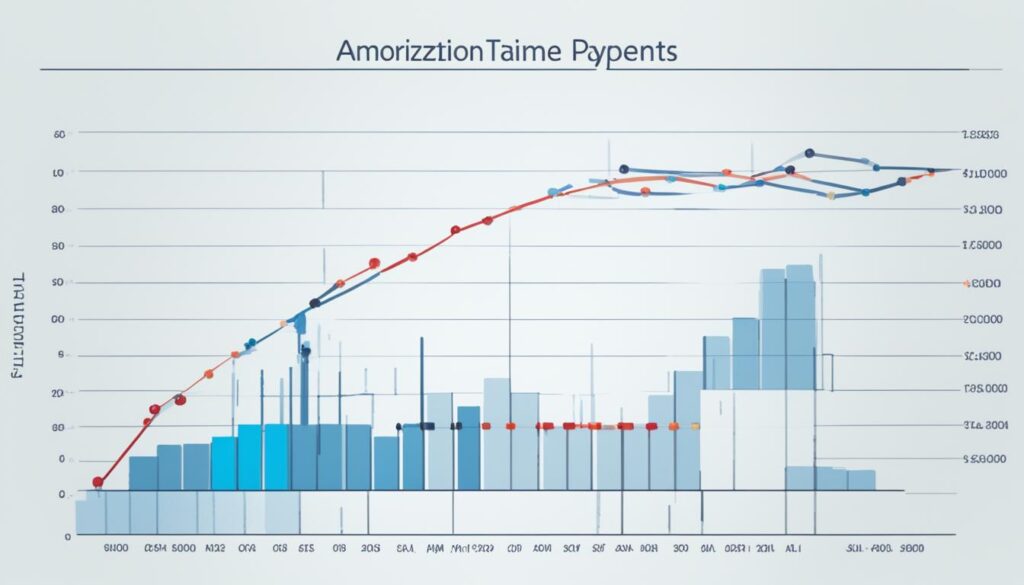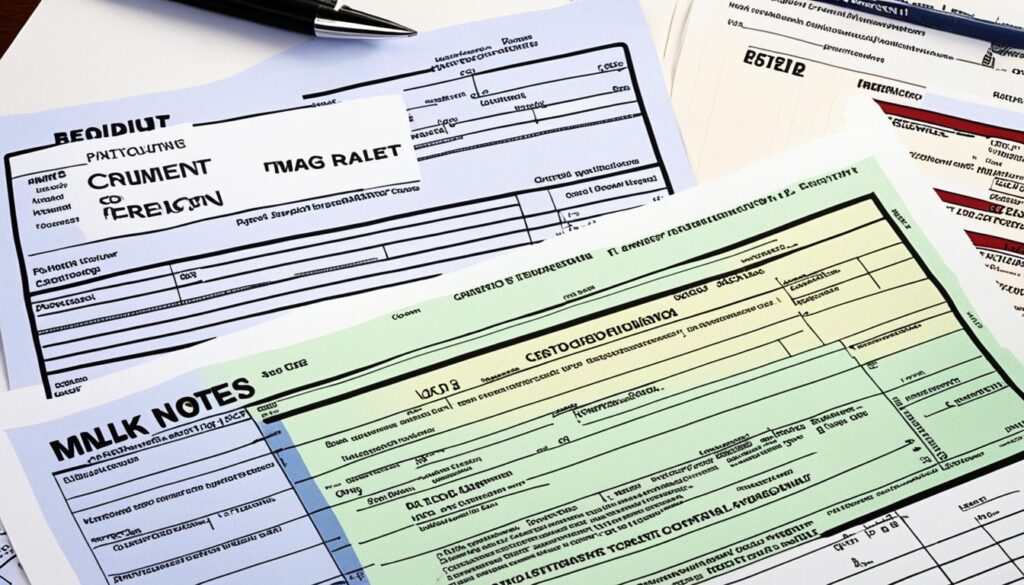A loan agreement is a vital legal document that establishes the terms and conditions of a loan. Whether it’s a simple promissory note between friends or a complex mortgage for a new home, loan agreements serve a crucial role in protecting the interests of both lenders and borrowers.
Loan agreements encompass various components that outline the specifics of the loan. They include important details such as the loan amount, interest rate, repayment terms, collateral, and default provisions. By clearly defining these elements, loan agreements help ensure a clear understanding of the borrower’s obligations and the lender’s rights.
Loan agreements are not limited to a specific type of loan. They can be used for personal loans, mortgages, auto loans, business loans, and even debt consolidation. Each type of loan agreement is tailored to the unique circumstances and requirements of the transaction, providing a secure framework for both parties involved.
Key Takeaways:
- A loan agreement is a legal document that specifies the terms and conditions of a loan.
- Components of a loan agreement include the loan amount, interest rate, repayment terms, collateral, and default provisions.
- Loan agreements can be used for personal loans, mortgages, auto loans, business loans, and debt consolidation.
- Loan agreements ensure a clear understanding of borrower obligations and lender rights.
- By having a loan agreement, both parties are protected and have legal recourse in case of breach or default.
Also Read : Borrowing With Confidence: Essential Tips For Securing Favorable Loan Terms
Different Types of Loan Agreements
When it comes to obtaining a loan, there are various types of loan agreements available to suit different financial needs. Understanding these options can help borrowers make informed decisions about which type of loan agreement is most suitable for their specific situation.
1. Personal Loan Agreements
Personal loan agreements are versatile and can be used for a variety of purposes, such as debt consolidation, home improvements, or unexpected expenses. These loans are typically unsecured, meaning they don’t require collateral, and the borrower’s creditworthiness plays a significant role in determining the loan amount and interest rate.
2. Mortgage Agreements
Mortgage agreements are specifically designed to finance the purchase of a home. These loans are secured by the property being purchased, which serves as collateral. The terms and conditions of a mortgage agreement can vary depending on the lender and the borrower’s financial circumstances.
3. Auto Loan Agreements
Auto loan agreements are used to finance the purchase of a vehicle. Like mortgage agreements, auto loans are secured by the vehicle itself. The loan terms typically depend on factors such as the borrower’s credit history, the vehicle’s value, and the desired loan duration.
4. Business Loan Agreements
Business loan agreements are specifically designed to assist entrepreneurs and companies in acquiring funds for various business-related purposes. These loans can help with startup costs, expansion initiatives, or working capital needs. Business loan agreements can be secured or unsecured, depending on the lender’s requirements and the borrower’s creditworthiness.
5. Debt Consolidation Agreements
Debt consolidation agreements are a useful tool for individuals with multiple outstanding debts. These agreements allow borrowers to combine their various debts into a single loan, simplifying the repayment process. By consolidating debts, borrowers can potentially reduce their overall interest rates and monthly payments, making it easier to manage their finances.
Each type of loan agreement serves a different purpose, making it essential for borrowers to understand their options before entering into any loan arrangement. By carefully considering their financial needs and goals, borrowers can choose the loan agreement that best aligns with their unique circumstances.
Also Read : The Power of Loan Amortization Calculators: Optimizing Your Financial Strategy
Whether it’s a personal loan, mortgage, auto loan, business loan, or debt consolidation agreement, borrowers should carefully review the terms and conditions of the loan before signing any documentation. This will help ensure that they fully understand their rights, responsibilities, and the financial implications of the loan. It’s also advisable to seek professional advice when necessary and to compare loan options and interest rates from different lenders to secure the most favorable terms.
Also Read : Loan Commitment Unveiled: Understanding Definition, Mechanisms, And Varieties
Key Components of a Loan Agreement
Loan agreements contain several essential components that define the terms and conditions of the loan. These components play a crucial role in outlining the rights and responsibilities of both the lender and the borrower. Understanding these key components is essential for both parties to ensure a clear and mutually beneficial agreement.
Loan Details
The loan details section of the agreement specifies important information such as the loan amount, term, interest rate, and any fees associated with the loan. These details provide clarity on the financial aspects of the loan, ensuring both parties are aware of the specific terms.
Collateral
Collateral serves as security for the loan and protects the lender in case of default. The agreement will outline the specific assets used as collateral, such as real estate, vehicles, or other valuable property. In the event of non-payment, the lender has the right to seize the collateral to recover their losses.
Interest Rate
The interest rate determines the cost of borrowing for the borrower. It is crucial to clearly state the interest rate in the loan agreement, whether it is a fixed rate or a variable rate. This ensures transparency and prevents any misunderstandings regarding the financial obligations.
Also Read : The Rollercoaster Of Variable Loan Interest Rates: Risks And Rewards
Payment Terms
The payment terms section specifies how and when the borrower will repay the loan. It includes important details such as the repayment schedule, payment method, and any additional conditions for early repayment or penalties for late payments. These payment terms provide clarity and help both parties plan for the loan’s repayment.
Default Clauses
In the unfortunate event of default, loan agreements include default clauses that define the consequences and actions that can be taken. These clauses outline the rights of the lender, such as pursuing legal action or demanding immediate repayment. It is important for both parties to understand the default clauses to ensure compliance and mitigate any potential risks.
Having a well-drafted loan agreement that clearly defines loan details, collateral, interest rate, payment terms, and default clauses is crucial for a secure and mutually beneficial lending relationship. These key components provide legal protection and clarity, ensuring that both the lender and the borrower understand their respective obligations and rights.
Also Read : Senior Bank Loans Decoded: Exploring Mechanics, Rates, And Potential Dangers

Importance of Loan Agreements
Loan agreements are a vital component of any borrowing arrangement, providing essential legal protection and ensuring clarity for both lenders and borrowers. Let’s explore why loan agreements are of significant importance:
Legal Recourse:
Loan agreements establish a framework for legal recourse in case of breach or default. By clearly outlining the rights and obligations of both parties, these agreements serve as a crucial reference point for resolving disputes and seeking appropriate remedies.
Loan Protection:
Loan agreements offer protection to both lenders and borrowers. They outline the terms and conditions of the loan, including the repayment schedule, interest rate, and any potential penalties or fees. This protection ensures that both parties are aware of their responsibilities and can make informed decisions.
Gift vs. Loan Differentiation:
Loan agreements help differentiate between a loan and a gift, which can have significant implications, especially from a tax perspective. By clearly documenting the terms of the loan, the agreement ensures that it is treated as a legitimate financial transaction rather than a gift.
Loan agreements separate a loan from a gift, ensuring compliance with tax regulations.
Court Enforcement:
In the unfortunate event of a dispute, loan agreements provide crucial evidence of the agreed-upon terms and conditions. This documentation is essential in court proceedings and strengthens the position of both lenders and borrowers, ensuring that their rights are protected and the agreed-upon terms are enforced.
Amortization Table:
Loan agreements, particularly those with interest, can include an amortization table. This table outlines the repayment schedule and interest calculations, providing borrowers with a clear understanding of their ongoing financial obligations.

Note: The image above represents an example of an amortization table, illustrating how loan payments are applied to both principal and interest over time.
In conclusion, loan agreements are essential documents that provide legal recourse, ensure loan protection, differentiate between loans and gifts, facilitate court enforcement, and provide clarity through an amortization table. These agreements are an invaluable tool for both borrowers and lenders, establishing clear terms and conditions and fostering a sense of trust and transparency in the borrowing process.
When to Use a Loan Agreement
Loan agreements play a crucial role in facilitating financial transactions and providing clarity for both borrowers and lenders. It is essential to use a loan agreement whenever there is a need to borrow or lend money. Let’s explore some scenarios where a loan agreement is particularly important:
Borrowing Money
Whether it’s for funding a business venture, covering unexpected expenses, or consolidating existing debts, borrowing money requires a loan agreement. By having a written agreement, all parties involved can establish clear terms and conditions, ensuring everyone understands their respective obligations.
Family and Friends Loans
When borrowing from family or friends, it’s tempting to rely solely on trust. However, even in these personal relationships, a loan agreement is crucial to avoid conflicts and maintain healthy relationships. With a formal written agreement, both parties have a clear understanding of the loan’s terms, repayment schedule, interest (if applicable), and any consequences in case of default.
Home or Vehicle Purchase
Home and vehicle purchases often involve significant amounts of money and can greatly impact individuals’ financial well-being. To protect both the buyer and the seller, a written agreement is vital. It outlines the agreed-upon sale price, payment schedule, interest rate (if financed), and any conditions related to the property or vehicle involved.
The Importance of a Written Agreement
Having a written loan agreement provides legal protection and serves as a reference point for resolving disputes. It ensures that all parties involved are on the same page and have a complete understanding of their responsibilities. This formal document acts as a safeguard, helping prevent misunderstandings, and providing a clear recourse in the event of a breach of contract or default.
A loan agreement is like a road map that guides both the borrower and the lender throughout the borrowing process. It offers peace of mind and establishes a foundation of trust between all parties involved.
By utilizing a loan agreement, individuals can navigate the complexities of borrowing and lending money in a transparent and responsible manner, promoting financial well-being and building stronger relationships.
Next, we will explore the intricacies of commercial loan agreements.
Commercial Loan Agreements
Commercial loan agreements are an essential part of the business world, involving complex loan structures and additional legal considerations. Unlike personal loans, commercial loans require a thorough underwriting process and often involve collateral security to protect the lender’s interests.
One key feature of commercial loan agreements is the inclusion of reporting requirements. Lenders may require regular financial statements and other documents to evaluate the borrower’s financial health and the value of the collateral. These reports help lenders assess the risk associated with the loan and make informed decisions.
Covenants, another important aspect of commercial loan agreements, outline specific actions or behaviors that the borrower must adhere to. These covenants ensure that the borrower maintains certain financial ratios, such as debt-to-equity or interest coverage ratios, to protect the lender’s investment.
Default clauses are also common in commercial loan agreements, outlining the consequences if the borrower fails to meet their obligations. These clauses provide a framework for initiating legal action and enforce the rights of the lender in case of default.
Benefits of Commercial Loan Agreements
Commercial loan agreements offer several advantages for both lenders and borrowers:
- Clear terms and conditions: Commercial loan agreements provide a clear understanding of the loan’s terms, repayment schedule, interest rate, and any additional fees involved.
- Legal protection: The agreement serves as a legally binding document that protects both parties in case of disputes or breaches.
- Asset collateralization: Collateral security ensures that the lender has a form of recourse if the borrower defaults on the loan.
Here’s an informative table summarizing the key features of commercial loan agreements:
| Features | Description |
|---|---|
| Complexity | Commercial loan agreements are more intricate compared to personal loans, requiring a thorough underwriting process and additional legal considerations. |
| Collateral Security | Commercial loans often involve collateral, such as real estate or business assets, to secure the lender’s investment. |
| Reporting Requirements | Lenders may require regular financial statements and reports to assess the borrower’s financial health and evaluate the collateral’s value. |
| Covenants | Commercial loan agreements may include covenants, specifying actions or behaviors that the borrower must adhere to, ensuring compliance with specific financial ratios or loan conditions. |
Now let’s take a visual break and have a look at the image below, highlighting the importance of complex loan agreements:

Commercial loan agreements are comprehensive contracts that require careful consideration and discussion between the parties involved. Legal counsel is often sought to ensure that the agreement meets the requirements of both lenders and borrowers and protects their respective interests.
Promissory Notes
A promissory note is a specific type of loan agreement commonly used by private lenders. It represents a borrower’s promise to repay a debt. Promissory notes are often utilized for shorter-term or unsecured loans. Private lenders, who are individuals or non-traditional financial institutions, play a significant role in providing borrowers with alternative lending options.
Unsecured loans do not require collateral, which means borrowers don’t need to provide any assets as security for the loan. Instead, private lenders rely on the borrower’s creditworthiness and potential repayment capacity when determining loan eligibility. Due to the absence of collateral, unsecured loans often come with higher interest rates to compensate for the additional risk taken on by the lender.
When multiple lenders are involved in a loan, an intercreditor agreement may be necessary to establish the priority rankings and rights of each lender. This agreement outlines the hierarchy of payment in the event of default or bankruptcy, ensuring a fair distribution of funds among the lenders.

Private lenders offer borrowers greater flexibility and accessibility, especially for those who may not qualify for traditional bank loans. However, it is essential for borrowers to carefully review the terms and conditions of any promissory note before committing to the agreement. It is recommended that both borrowers and lenders consult legal counsel to ensure that all legal requirements and provisions are properly addressed.
Also Read:- Unlock Funds Fast with a Personal Loan
Example of a Promissory Note
“I, [Borrower’s Name], promise to pay [Lender’s Name] the principal sum of $[Loan Amount] in accordance with the terms specified in this promissory note. The loan shall bear an annual interest rate of [Interest Rate]% with monthly repayments of $[Monthly Payment Amount] due on the [Due Date] of each month, commencing on [Start Date], until the loan is fully paid.”
Here is an example of a promissory note that outlines the key elements of the loan agreement:
| Term | Description |
|---|---|
| Borrower’s Name | The legal name of the borrower. |
| Lender’s Name | The legal name of the lender. |
| Loan Amount | The total amount of the loan. |
| Interest Rate | The annual interest rate applied to the loan. |
| Monthly Payment Amount | The fixed amount to be paid by the borrower on a monthly basis. |
| Due Date | The specific date on which the monthly payments are due. |
| Start Date | The date when the borrower starts making repayments. |
Additional Resources and Terminology
Loan agreements involve various terms and concepts that borrowers should be familiar with. Understanding these terms can help borrowers navigate the loan process and make informed decisions. Below are some key loan agreement terms and concepts to know.
Loan Underwriting
Loan underwriting is the process of assessing a borrower’s creditworthiness. Lenders evaluate factors such as the borrower’s credit history, income, and financial stability to determine if they qualify for a loan and at what interest rate.
Default
Default occurs when a borrower fails to fulfill their obligations under the loan agreement. This can include failure to make timely payments, providing false information, or violating other terms outlined in the agreement. Default can have serious consequences, such as damage to the borrower’s credit score and legal action by the lender.
Interest-Only Payment
In some loan agreements, borrowers may have the option of making interest-only payments during a specified period before transitioning to regular principal and interest payments. This allows borrowers to manage their cash flow more effectively, but it’s important to note that the principal balance will still need to be repaid at the end of the interest-only period.
Amortization
Amortization refers to the gradual repayment of a loan over time. It involves making regular payments that include both principal and interest. The payments are typically structured to ensure that the loan is fully repaid by the end of the agreed-upon term.
Balloon Payment
A balloon payment is a larger final payment that is due at the end of the loan term. This payment is typically higher than the regular monthly payments and is used to pay off the remaining balance in full. Balloon payments are commonly seen in mortgage loans or other long-term financing arrangements.
Additional Resources
For further information on loan agreement terms and concepts, the following resources may be helpful:
- Financial institutions: Speak with representatives from banks, credit unions, or online lenders who can provide personalized information and guidance on loan agreements.
- Online research: Conducting internet searches and visiting reputable financial websites can offer insights into loan agreement terms and related topics.
- Legal counsel: Consulting with an attorney specializing in contract law can provide expert advice and ensure that your loan agreement is legally sound.
By familiarizing yourself with loan agreement terms and concepts, you can confidently navigate the borrowing process and make informed decisions that align with your financial goals and circumstances.
Conclusion
Loan agreements are of utmost importance in the lending process, providing essential legal protection and clarity for both borrowers and lenders. These agreements clearly outline the responsibilities and obligations of each party, ensuring that the loan is repaid as agreed upon. By understanding the components and terms of a loan agreement, borrowers can make informed decisions and fulfill their responsibilities in a timely manner.
Not only do loan agreements offer legal protection, but they also grant lenders the right to enforce their rights through the legal system if necessary. In case of default, lenders can rely on the terms stated in the loan agreement to seek recourse and take appropriate action. This ensures that lenders are safeguarded and have the means to recover any outstanding debts.
Ultimately, loan agreements serve as an essential tool for establishing clear loan terms and conditions. They provide a foundation for a mutually beneficial relationship between borrowers and lenders, promoting transparency and trust. Whether it’s for personal loans, mortgage agreements, or business financing, loan agreements play a vital role in protecting the interests of all parties involved.
FAQs
Q: What is the purpose of a loan agreement?
A: A loan agreement is a legal document that outlines the terms and conditions of a loan between a lender and a borrower.
Q: What components are typically included in a loan agreement?
A: A loan agreement usually includes details such as the loan amount, interest rate, repayment terms, consequences of default, and any collateral or guarantees.
Q: How can I write a personal loan agreement?
A: You can write a personal loan agreement by using a template or consulting with a legal professional to ensure all necessary terms are included.
Q: What is a charge on a personal loan?
A: A charge on a personal loan refers to any assets or property that a borrower pledges as security for the loan.
Q: Why is it important to have a loan agreement template?
A: Having a loan agreement template can help both parties clearly document the terms of the loan and avoid misunderstandings or disputes in the future.
Q: What does “entire agreement” mean in the context of a loan agreement?
A: The term “entire agreement” signifies that the written loan agreement contains all the terms agreed upon by the parties, superseding any prior discussions or agreements.
Q: How does a loan agreement protect both the lender and the borrower?
A: A loan agreement protects both parties by clearly defining the terms of the loan, setting out expectations for repayment, and establishing consequences for default or breach of the agreement.
Q: What should be included in a loan agreement to ensure clarity and compliance?
A: A loan agreement should include details such as the principal of the loan, repayment schedule, interest rates, provision for late payments, and procedures for addressing disputes.
